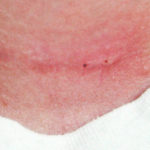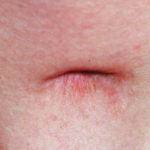Unsightly neck scars from a previous tracheostomy are not uncommon. The prominent location in the center of the neck and the nature of the placement and removal of the tracheostomy often leaves a visible depressed scar. The classic appearance is that resembling an umbilicus with the circular skin edges tethered down to the deeper tissues. Some call this a tracheal tug but its origin is that soft tissue (fat) is lost between the skin and the underlying strap muscles and trachea.
A depressed tracheostomy scar can really be revised within the first three months after the tube has been removed. While some advocate waiting until the scar is mature (greater than six months), there is really little benefit to such a delayed approach. The reconstructive techniques needed are not adversely effected by an immature scar. It is understandable why a patient would like to shed as soon as possible any physical signs of the experience.

Tracheostomy scar revision can be done under local anesthesia, if desired, as a simple outpatient procedure. A fine line red scar will exist for awhile but the final goal of a pencil line thin scar can usually be obtained in most cases. It is necessary to completely resolve the skin adherence to the trachea to significantly improve scar appearance in this very noticeable location.
Dr. Barry Eppley
Indianapolis, Indiana



